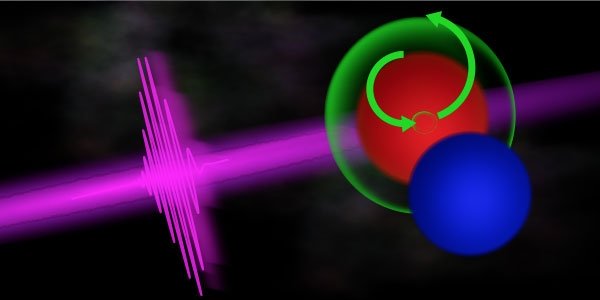The Science
In a new experiment, researchers observed the production of electronic excitations near a single atom in a molecule. The excitation is caused by a process called impulsive stimulated X-ray Raman scattering of X-ray pulses that last less than a femtosecond—a millionth of a billionth of a second. The target atom in the molecule absorbs an X-ray photon that excites an electron in the atom’s core to a highly excited level in the atom’s outer shell. Before this short-lived state can decay, a second photon drives an electron from a different position in the outer shell to fill the vacancy in the core. This leaves the atom with a filled core of electrons, but with an excited electron in its outer shell. The resulting excitation, called a valence excitation, happens at a very precise time and place— occurring within a femtosecond and initially localized near the atom in the molecule that absorbed the X-ray photon.
The Impact
The combination of X-ray Raman scattering and the cutting-edge capability to produce X-ray pulses that last less than a femtosecond gives scientists a powerful new research tool. The combination allows them to view motion in molecules at atom-scale resolution. These observations are crucial to understanding chemical reactions involving light.
Summary
Researchers performed the first experiment at the Linac Coherent Light Source (LCLS) using 100-gigawatt, sub-femtosecond-duration, soft X-ray pulses produced by a new technology called X-ray laser-enhanced attosecond pulse generation (XLEAP). Following the interaction of the ultrashort X-ray pulses with nitric oxide molecules, the researchers confirmed the production of valence excitation in neutral nitric oxide due to impulsive stimulated X-ray Raman scattering. This work sets the stage for future experiments that can resolve the evolution of localized valence excitations in neutral molecules, with the potential to provide key, new insight as to how electronic motion and coherence drive ultrafast chemistry.
Funding
This research was primarily supported by the Department of Energy (DOE) Office of Science, Office of Basic Energy Sciences (BES). Specifically, it was supported by the Atomic, Molecular and Optical Sciences program in the Chemical Sciences, Geosciences, and Biosciences Division of BES. This work was also supported by the DOE BES Accelerator and detector research program. Additional support was provided by the Spanish Ministry of Science, Innovation and Universities (MCIU/AEI/FEDER) and computing resources from the Spanish Center for Scientific Computing (CCC-UAM). Funding was also provided by the United Kingdom’s Engineering and Physical Sciences Research Council. LCLS is a DOE Office of Science user facility.


